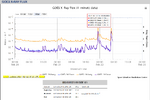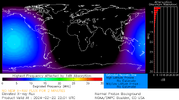You are using an out of date browser. It may not display this or other websites correctly.
You should upgrade or use an alternative browser.
You should upgrade or use an alternative browser.
Sol (Sun) and its phenomena
- Thread starter mabar
- Start date
Another X 1.7 flare, most probably from the same sunspot AR 3590, 06:32 GMT :
Yep, from AR3590... We are being lucky, says Dr. Ryan French.
Sunspot region 3590 woke up while Europe was sleeping. In the span of just 7 hours she produced two impulsive X1 solar flares but unfortunately none of them were eruptive. Let's hope the region continues to develop and produces an earth-directed eruption now that she rotates into an earth-facing position.
SpaceWeatherlive.com
I guess NOAA will have to re-adjust its parametersNOAA's solar flare forecast has been updated for the next 24 hours: 99% chance of C flares, 30% chance of M flares and 10% chance of X flares.
Wow, another one... Bigger than the the other two
From SpaceWeather
|
This figure shows a series of solar flares detected by NOAA satellites in July 2000: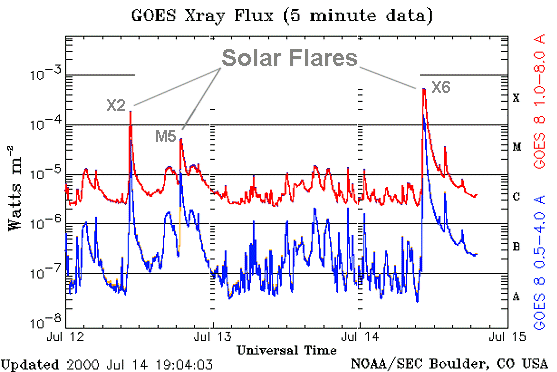
Each category for x-ray flares has nine subdivisions ranging from, e.g., C1 to C9, M1 to M9, and X1 to X9. It's a logartithmic scale. M1 is 10 times stronger than C1. X1 is 10 times stronger than M1, and so on. In the figure, above, the three indicated flares registered (from left to right) X2, M5, and X6. The X6 flare triggered a radiation storm around Earth nicknamed the Bastille Day event. |
Last edited:
I was left with the question mark with the Bastille event, found this.
The Bastille Day
Event
The Bastille Day
Event
You know a solar flare is strong when even the Voyager spacecraft feel it. Twenty-two years ago today (July 14, 2000) the sun exploded with so much force, it sent shockwaves to the edge of the solar system.
Earth was on the doorstep of the blast, nicknamed the “Bastille Day Event” because it happened on the national day of France. Subatomic particles accelerated by the flare peppered satellites and penetrated deep into Earth’s atmosphere. Radiation sensors on Earth’s surface registered a rare GLE–a “ground-level event.”
People flying in commercial jets at high latitudes would have received double their usual radiation dose,” says Clive Dyer of the University of Surrey Space Centre in Guildford UK, who studies extreme space weather. “It was quite an energetic event–one of the strongest of the past 20 years.”
A day later the CME arrived. Impact on July 15th sparked an extreme (Kp=9) geomagnetic storm. The sun had just set on the east coast of North America when the first auroras appeared.
“I was out in the yard doing chores and saw bright red auroras straight overhead,” recalls Uwe Heine of Caswell County, North Carolina. “I called over to our neighbor, Carrie, who was also outside. I told her those were not sunset colors. It was an aurora, and super rare to see this far south!”
A few other storms of the Space Age have have been equally strong, but the Bastille Day Event is special to researchers. It was the first major solar storm after the launch of SOHO, the Solar and Heliospheric Observatory. Data from the revolutionary young satellite taught researchers a lot, very quickly, about the physics of extreme flares.
Tibor Török of Predictive Science, Inc., is one of many researchers still studying the Bastille Event decades later. “The event took place close to disk center, so we had a great view of the action,” he says. Török recently applied a modern magnetohydrodynamic (MHD) computer model to some of the data, and found that 1033 ergs of magnetic energy were released in the explosion–about the same as a thousand billion WWII atomic bombs.
No wonder the Voyagers felt it.
It took the Bastille Day CME months to reach the distant spacecraft. Voyager 2 felt it 180 days later, Voyager 1 took 245 days. Being near the edge of the solar system, both spacecraft were naturally bathed in high levels of cosmic rays. The CME swept aside that ambient radiation, creating a temporary reduction called a “Forbush Decrease.” Conditions returned to normal 3 to 4 months later and, finally, the storm was over.
Last edited:
SOLAR CYCLE 25 ACTIVITY REPORT FEBRUARY 23_2024
Solar activity has been at high levels for the past 24 hours. AR3590 has shown us what it means to be an active region:
● X1.8 at 23:07 UTC on February 21 the flare caused a Strong R3 shortwave radio blackout over the western USA and Pacific Ocean.
● X1.7 at 06:32 UTC on February 22 the flare caused a Strong R3 shortwave radio blackout over the western Pacific Ocean.
● M4.7 at 20:46 UTC the flare caused a Minor R1 shortwave radio blackout over the western USA and Pacific Ocean.
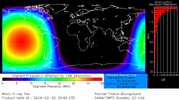
● X6.3 at 22:34 UTC the flare caused a Strong R3 shortwave radio blackout over the western Pacific Ocean.
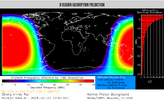
The total number of sunspots has increased to 46 of which 26 of them are grouped into 2 active regions as follows: AR3586 & AR8390
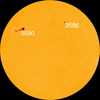
AR3584 is gone
● Auroral Activity
Aurora Oval Bz: -0.92 nT South
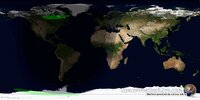
● Current Conditions at 04:40 UTC on February 23
▪︎ Geospace quiet (Kp 0)
▪Solar wind speed record: 337 km/sec (Normal speed)
▪︎ density: 2.02 p/cm³ (low density)
▪︎ Interplanetary Magnetic Field (IMF)
Bt: 5 nT
▪︎ X-ray Solar Flare: X6 2234 UT Feb22
▪︎ Thermosphere Climate Index
today: Warm
▪︎ Neutron Counts today: -5.2 % (Low)
▪︎ Sunspot number: 46 (SN 45 Feb 22)
▪︎ Spotless Days 2023 total: 0 days (0%)
▪︎ According to SDO a stream of solar wind flowing from a southern coronal hole could hit Earth on Feb. 26th
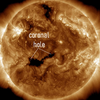
.......
SpaceWeatherlive.com
SpaceWeather.com
Solar activity has been at high levels for the past 24 hours. AR3590 has shown us what it means to be an active region:
● X1.8 at 23:07 UTC on February 21 the flare caused a Strong R3 shortwave radio blackout over the western USA and Pacific Ocean.
● X1.7 at 06:32 UTC on February 22 the flare caused a Strong R3 shortwave radio blackout over the western Pacific Ocean.
● M4.7 at 20:46 UTC the flare caused a Minor R1 shortwave radio blackout over the western USA and Pacific Ocean.

● X6.3 at 22:34 UTC the flare caused a Strong R3 shortwave radio blackout over the western Pacific Ocean.

LARGEST FLARE FOR OVER 6 YEARS: Sunspot region AR3590 just produce the largest flare of Solar Cycle 25 which makes it the largest flare since 2017! It was an X6 flare. That is 3 X flares just today and 6 for the month so far. More to come? Keith Strong vía X
The total number of sunspots has increased to 46 of which 26 of them are grouped into 2 active regions as follows: AR3586 & AR8390

AR3584 is gone
NOAA's solar flare forecast has been updated for the next 24 hours: 99% chance of C flares, 60% chance of M flares and 30% chance of X flares.
AR8390 is now a colossal 900MH sunspot, which means it is five times larger than Earth. The region continues with a beta-gamma-delta magnetic field that harbors energy for X-class flares. This region is now composed of 24 sunspots and according to NOAA forecasts, has a 60% chance of producing M-class flares and a 30% chance of X-class flares.
AR8390 is now a colossal 900MH sunspot, which means it is five times larger than Earth. The region continues with a beta-gamma-delta magnetic field that harbors energy for X-class flares. This region is now composed of 24 sunspots and according to NOAA forecasts, has a 60% chance of producing M-class flares and a 30% chance of X-class flares.
● Auroral Activity
The geomagnetic field has been at quiet levels (Kp1) for the past 24 hours. On February 22 Solar wind speed reached a peak of 377 km/s (Normal speed) at 23:39 UTC Total IMF reached 8 nT at 22:09 UTC
Aurora Oval Bz: -0.92 nT South

● Current Conditions at 04:40 UTC on February 23
The solar wind speed is currently at normal levels of about 337 km/s. The auroral oval map shows little chance of observing auroral conditions at high latitudes. There are low levels of protons per cm³ in the atmosphere and the interplanetary magnetic field has had a low impact on the Earth's magnetic field. The last recorded solar flare was an X6.3 at 22:34 UTC on February 22. The number of sunspots increased to 46. Everything seems to indicate that AR3590 still has a lot to show. So far none of the X events that AR3590 has generated appear to have produced Coronal Mass Ejections. That could change as the region continues to move toward an Earth-facing position... next week 



CELL PHONE OUTAGE: While solar flares can affect communication systems, it is highly unlikely that these two X-flares contributed to today's widely reported cell phone outages. The flares, while intense, did not cause a solar radiation storm. Moreover, the shortwave radio blackouts they did cause were too brief and too low in frequency to interfere with most cell phone communications. Other explanations are more likely. SpaceWeather.com
▪︎ Geospace quiet (Kp 0)
▪Solar wind speed record: 337 km/sec (Normal speed)
▪︎ density: 2.02 p/cm³ (low density)
▪︎ Interplanetary Magnetic Field (IMF)
Bt: 5 nT
▪︎ X-ray Solar Flare: X6 2234 UT Feb22
▪︎ Thermosphere Climate Index
today: Warm
▪︎ Neutron Counts today: -5.2 % (Low)
▪︎ Sunspot number: 46 (SN 45 Feb 22)
▪︎ Spotless Days 2023 total: 0 days (0%)
▪︎ According to SDO a stream of solar wind flowing from a southern coronal hole could hit Earth on Feb. 26th

.......
SpaceWeatherlive.com
SpaceWeather.com
Attachments
I found yesterday XCELL PHONE OUTAGE: While solar flares can affect communication systems, it is highly unlikely that these two X-flares contributed to today's widely reported cell phone outages. The flares, while intense, did not cause a solar radiation storm. Moreover, the shortwave radio blackouts they did cause were too brief and too low in frequency to interfere with most cell phone communications. Other explanations are more likely. SpaceWeather.com
posts by Ben (SunWeatherMan)
alluding that the flare(s) of the last days had
knocked out one of the satellites and therefore the outage of the networks, good thing he took out this video, it explains it better and it seems plausible to me.
I
Here is his commentary on yesterday's video
MAJOR NETWORK OUTAGES | Solar Flare Impact?
shown above
@Suspicious0bservers
...
- The largest and most complex networks are the most vulnerable - thats the USA.
- No, we would not expect it to hit everything... and in fact, this is the most widespread (number/range of networks) solar impact in technological history.
- It is a HUGE risk to do a cyber attack... so they took a risk on secondary infrastructure and didnt attack power, water, military? I don't think so.
-Ionospheric waves (from this event) can be up to 300km long, which is a long distance between peak impact areas... so you shouldn't expect everything to be hit unless its a super flare.
- Ionospheric impact goes global in minutes... the part of earth facing the sun ONLY matters for HF radio propagation.
...
SOLAR CYCLE 25 ACTIVITY REPORT FEBRUARY 24_2024
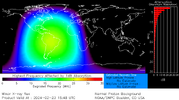
● M2.6 at 17:47 UTC the flare generated a Minor R1 radio blackout over South Pacific Ocean
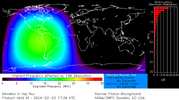
The total number of sunspots has increased to 116 of which 56 of them are grouped into 6 active regions as follows: AR3586, AR8390 & new regions AR3591, AR8392, AR8393, AR3594

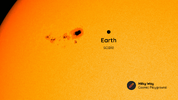
● Auroral Activity
Aurora Oval Bz: 2.74 nT North
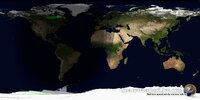
● Current Conditions at 04:50 UTC on February 24
▪︎ Geospace quiet (Kp 1)
▪Solar wind speed record: 318 km/sec (Normal speed)
▪︎ density: 1.79 p/cm³ (low density)
▪︎ Interplanetary Magnetic Field (IMF)
Bt: 5.38 nT
▪︎ X-ray Solar Flare: C5 0353 UT Feb24
▪︎ Thermosphere Climate Index
today: Warm
▪︎ Neutron Counts today: -5.3 % (Low)
▪︎ Sunspot number: 116 (SN 46 Feb 23)
▪︎ Spotless Days 2023 total: 0 days (0%)
▪︎ According to SDO a stream of solar wind flowing from a southern coronal hole could hit Earth on Feb. 26th

.......
SpaceWeatherlive.com
SpaceWeather.com
Solar activity has been at moderate levels for the past 24 hours. AR3590 region did not rest and generated three M-class flares and several C-class.
● M1 at 13:28 UTC the flare generated a Minor R1 radio blackout over South Atlantic Ocean

● M1.4 at 15:53 UTC the flare generated a Minor R1 radio blackout over South America
● M1 at 13:28 UTC the flare generated a Minor R1 radio blackout over South Atlantic Ocean

● M1.4 at 15:53 UTC the flare generated a Minor R1 radio blackout over South America

● M2.6 at 17:47 UTC the flare generated a Minor R1 radio blackout over South Pacific Ocean

THREE X-FLARES, ZERO CMES: Giant sunspot AR3590 is living up to the hype. In only 23 hours spanning Feb. 21-22, the active region unleashed three powerful X-class solar flares (X1.8, X1.7 and X6.3). The X6.3 flare is the strongest of Solar Cycle 25, so far, and the most powerful flare since the great solar storms of Sept. 2017. You might think all these flares would have hurled at least one CME toward Earth. In fact, the number is zero SpaceWeather.com
The total number of sunspots has increased to 116 of which 56 of them are grouped into 6 active regions as follows: AR3586, AR8390 & new regions AR3591, AR8392, AR8393, AR3594

NOAA's solar flare forecast remains for the next 24 hours: 99% chance of C flares, 60% chance of M flares and 30% chance of X flares.
AR3586 and the new regions have stable magnetic fields while AR3590 continues with its unstable beta-gamma-delta field.
AR3590 has increased in size to 1150 “millionths of a solar hemisphere” (MH) and is now 6.5 times larger than Earth. It went from a complex of 24 sunspots to 44 and according to NOAA forecasts, has a 40% chance of producing M-class flares and a 20% chance of X-class flares.
AR3586 and the new regions have stable magnetic fields while AR3590 continues with its unstable beta-gamma-delta field.
AR3590 has increased in size to 1150 “millionths of a solar hemisphere” (MH) and is now 6.5 times larger than Earth. It went from a complex of 24 sunspots to 44 and according to NOAA forecasts, has a 40% chance of producing M-class flares and a 20% chance of X-class flares.

● Auroral Activity
The geomagnetic field has been at quiet levels (Kp1) for the past 24 hours. On February 23 Solar wind speed reached a peak of 368 km/s (Normal speed) at 23:15 UTC Total IMF reached 6 nT at 16:39 UTC
GEOMAGNETIC STORM WATCH (G1): Minor G1-class geomagnetic storms are possible on Feb. 25th when a CME is expected graze Earth's magnetic field. The CME was *not* produced by this week's X-flares. Instead, it was hurled into space by an erupting filament of magnetism (movie) on Feb. 21st. SpaceWeather.com
Aurora Oval Bz: 2.74 nT North

● Current Conditions at 04:50 UTC on February 24
The solar wind speed is currently at normal levels of about 300 km/s. The auroral oval map shows little chance of observing auroral conditions at high latitudes. There are low levels of protons per cm³ in the atmosphere and the interplanetary magnetic field has had a low impact on the Earth's magnetic field. The last recorded solar flare was a C5 at 03:53:UTC on February 24. The number of sunspots increased to 116. It was confirmed that the X-class flares from AR3590 did not produce Coronal Mass Ejections, however, there is a possibility of a geomagnetic storm due to the rupture of a magnetic filament.
▪︎ Geospace quiet (Kp 1)
▪Solar wind speed record: 318 km/sec (Normal speed)
▪︎ density: 1.79 p/cm³ (low density)
▪︎ Interplanetary Magnetic Field (IMF)
Bt: 5.38 nT
▪︎ X-ray Solar Flare: C5 0353 UT Feb24
▪︎ Thermosphere Climate Index
today: Warm
▪︎ Neutron Counts today: -5.3 % (Low)
▪︎ Sunspot number: 116 (SN 46 Feb 23)
▪︎ Spotless Days 2023 total: 0 days (0%)
▪︎ According to SDO a stream of solar wind flowing from a southern coronal hole could hit Earth on Feb. 26th
.......
SpaceWeatherlive.com
SpaceWeather.com
Whatever happened with AT&T and Verizon is not related to the Sun, notes Dr. Ryan French. One of the main reasons is that there was no CME and if there had been a CME it would have taken days to arrive to generate the necessary SEVERE geomagnetic storm.
Out of sensationalism, something went wrong, or a cyber attack test was done.
Dr. Ryan French, explains how big flares without CMEs are not big space weather threat
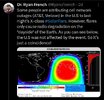
Out of sensationalism, something went wrong, or a cyber attack test was done.
Dr. Ryan French, explains how big flares without CMEs are not big space weather threat

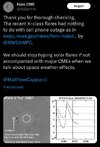
Olivierlejardinier
Jedi Council Member
Here are some more details, from Spaceweather.com :Out of sensationalism, something went wrong, or a cyber attack test was done.
CELL NETWORK OUTAGE EXPLAINED: A 12-hour outage of AT&T's network on Thursday interrupted cell phone service for tens of thousands of Americans. The outage coincided with a series of X-class solar flares from giant sunspot AR3590. However, the solar flares have been exonerated. AT&T did it to themselves. "Based on our initial review, we believe the outage was caused by the application and execution of an incorrect process used as we were expanding our network," the company reported.
That works for AT&T, ok. And the other networks that went down? Will they come out with a similar explanation or will it be lost or misplaced among the news that will be piling up?Here are some more details, from Spaceweather.com :CELL NETWORK OUTAGE EXPLAINED: A 12-hour outage of AT&T's network on Thursday interrupted cell phone service for tens of thousands of Americans. The outage coincided with a series of X-class solar flares from giant sunspot AR3590. However, the solar flares have been exonerated. AT&T did it to themselves. "Based on our initial review, we believe the outage was caused by the application and execution of an incorrect process used as we were expanding our network," the company reported.
I think it would be too inconvenient for many to enter into swampy waters, not being able to have control of everything.
I am more with this:
Mytja
Jedi Master
The guy on the X video sounds convincing, no doubt, moreover because he uses some really strong emotional hooks and bombing the viewers to feel inadequate if they might disagree with what he says.That works for AT&T, ok. And the other networks that went down? Will they come out with a similar explanation or will it be lost or misplaced among the news that will be piling up?
I think it would be too inconvenient for many to enter into swampy waters, not being able to have control of everything.
I am more with this:
Concerning if the solar flares are to blame or not for this incident, it might be appropriate to check if something similar happened in early September 2017 when there were more of them in short time span and some of them then were much stronger, like X13 for example.

Top 50 solar flares of the year 2017 | Solar activity
On this page you will find an overview of the strongest solar flares of the year 2017 together with links to more information in our archive and a video (if available) of the event.
Maybe a coincidence, or perhaps not, it's interesting to note the timing with all the fuss about the satellite killer nuclear weapons that's been going on in public media space recently.
Truth be told, I'm a bit surprised the Yankee Deep State hasn't pinned this blackout to the Ruskies and evil monster Putin yet. And maybe, behind it all, they were in fact checking and preparing the damage control reaction for a potential future interview ala Tucker did with Putin, who knows...
That works for AT&T, ok. And the other networks that went down? Will they come out with a similar explanation or will it be lost or misplaced among the news that will be piling up?
I think it would be too inconvenient for many to enter into swampy waters, not being able to have control of everything.
Possibly it was a test as Elon Musk seems to have suggested. I am convinced that the Sun had nothing to do with it, because in previous occasions, not so long ago, the X-class flare did not cause the same phenomenon even when there was an associated CME... check the impact on December 14, 2023 with a X2.8 and a CME associated. North America was among the regions affected by the radio blackout, including Mexico, and no incidents were reported.

STRONGEST FLARE OF THE CURRENT SOLAR CYCLE: Sunspot 3514 erupted on Dec. 14th (1702 UT), producing a strong X2.8-class solar flare. This is the strongest flare of Solar Cycle 25 (so far) and the most powerful eruption the sun has produced since the great storms of Sept. 2017. NASA's Solar Dynamics Observatory recorded the extreme ultraviolet flash:
Geomagnetic storm 4 days later and no communication outages recorded
The geomagnetic field has been at unsettled to major storm levels for the past 24 hours. On December 18th Minor G1 geomagnetic storm (Kp5) threshold reached at 07:38 UTC, Moderate G2 geomagnetic storm (Kp6) threshold reached at 08:11 UTC, Solar wind speed reached a peak of 581 km/s (Moderately high speed) at 20:36 UTC
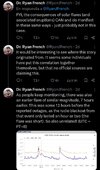
This comment is interesting... "Unless the geomagnetic field strength has suddenly dropped much more than expected..."

Concerning if the solar flares are to blame or not for this incident, it might be appropriate to check if something similar happened in early September 2017 when there were more of them in short time span and some of them then were much stronger, like X13 for example.
It did not happen something similar to what is blamed on the sun with the recent X class flares. Even the impact was R3 and caused a radiation storm at the poles. It happened on September 6, 2017 with a X9.3
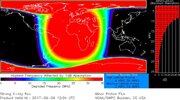
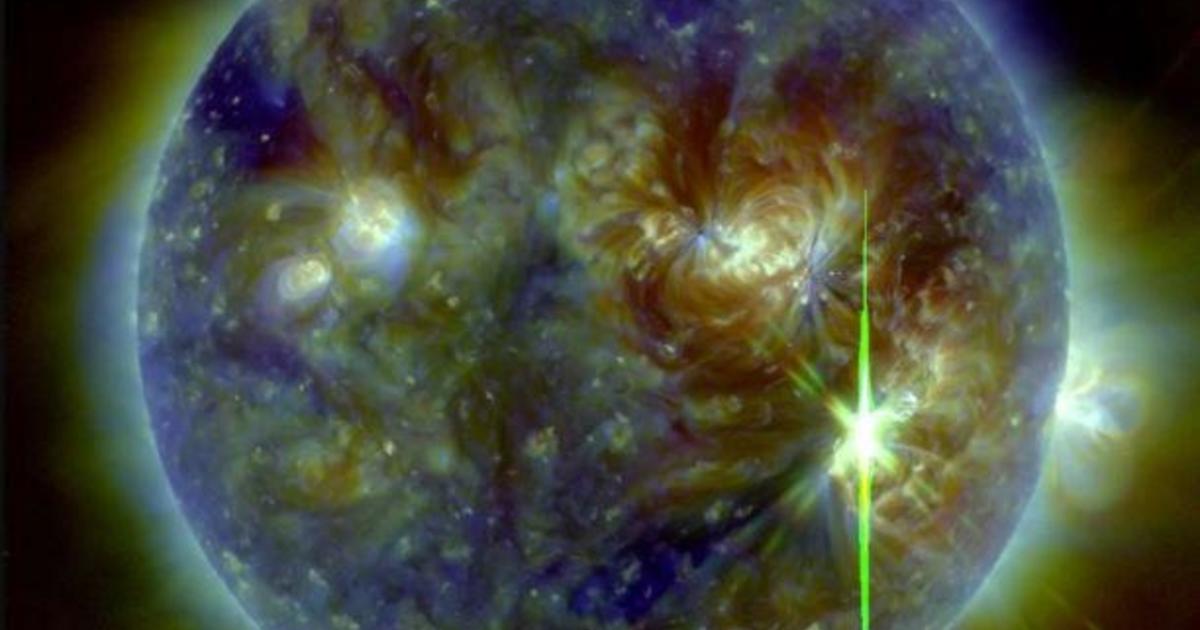
Biggest solar flare in a decade causes radio blackout
Government space weather center says pair of flares caused "wide area of blackouts, loss of contact for up to an hour"
SOLAR CYCLE ACTIVITY REPORT FEBRUARY 25_2024
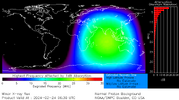
● M2.1 at 10:57 UTC the flare generated a Minor R1 radio blackout over Africa

● M3.6 at 11:18 UTC the flare generated a Minor R1 radio blackout over West Africa

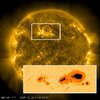
The total number of sunspots has decreased to 106 of which 56 of them are grouped into 5 active regions as follows: AR3586, AR8390, AR3591, AR8392, AR3594
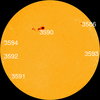
AR8393 is gone
NOAA's solar flare forecast was updated for the next 24 hours: 99% chance of C flares, 70% chance of M flares and 30% chance of X flares.
● Auroral Activity
Aurora Oval Bz: -2.58 nT South
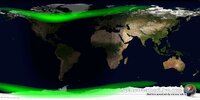
● Current Conditions at 04:03 UTC on February 25

▪︎ Geospace quiet (Kp 1)
▪Solar wind speed record: 450 km/sec (Elevated speed)
▪︎ density: 3.38 p/cm³ (low density)
▪︎ Interplanetary Magnetic Field (IMF)
Bt: 8.52 nT
▪︎ X-ray Solar Flare: C2 0050 UT Feb25
▪︎ Thermosphere Climate Index
today: Warm
▪︎ Neutron Counts today: -4.5 % (Low)
▪︎ Sunspot number: 106 (SN 116 Feb 24)
▪︎ Spotless Days 2023 total: 0 days (0%)
▪︎ According to SDO a stream of solar wind flowing from a southern coronal hole could hit Earth on Feb. 26th
.......
SpaceWeatherlive.com
SpaceWeather.com
Solar activity has been at moderate levels for the past 24 hours. AR8390 (N18W01) has produced three M-class flares and several C-class flares on February 24
● M4.5 at 06:34 UTC the flare generated a Minor R1 radio blackout over Indian Ocean

● M2.1 at 10:57 UTC the flare generated a Minor R1 radio blackout over Africa

● M3.6 at 11:18 UTC the flare generated a Minor R1 radio blackout over West Africa

Sunspot region 3590 is nearing the center disk and remains by far the most active and most complex region on the disk. It produced many M-class and three X-class solar flares but has yet to launch a CME. However, the region continues to develop and absolutely does have the potential for more X-class activity and launch a CME at Earth in case of an eruptive event. SpaceWeatherlive on X

WHAT MAKES THIS SUNSPOT SO DANGEROUS? Don't be surprised if there's another X-flare this weekend. Giant sunspot AR3590 is directly facing Earth, and it has an unstable magnetic field that harbors energy for the strongest explosions. This magnetic map from NASA's Solar Dynamics Observatory shows what makes the sunspot so dangerous:
Most sunspots have a simple magnetic field with only two poles: + (plus) and - (minus) . Sunspot AR3590 is more like a layer cake with a whole stack of pluses and minuses. Opposite magnetic polarities pressed together in this way can lead to explosive magnetic reconnection--the mechanism behind solar flares. Indeed, only two days ago AR3590 unleashed the strongest solar flare of Solar Cycle 25 (X6.3). SpaceWeather.com
The total number of sunspots has decreased to 106 of which 56 of them are grouped into 5 active regions as follows: AR3586, AR8390, AR3591, AR8392, AR3594

AR8393 is gone
NOAA's solar flare forecast was updated for the next 24 hours: 99% chance of C flares, 70% chance of M flares and 30% chance of X flares.
AR3590 has increased in size to 1400 “millionths of a solar hemisphere” (MH) and is now 8.2 times larger than Earth. It went from a complex of 44 sunspots to 45 and according to NOAA forecasts, has a 99% chance of producing C-class flares, 70% chance of producing M-class flares and a 30% chance of X-class flares.
● Auroral Activity
The geomagnetic field has been at quiet to unsettled levels (Kp3) for the past 24 hours. On February 24 Solar wind speed reached a peak of 408 km/s (Elevated speed) at 16:21 UTC Total IMF reached 11 nT at 19:52 UTC
Aurora Oval Bz: -2.58 nT South

● Current Conditions at 04:03 UTC on February 25
The solar wind speed has increased and is currently at elevated levels exceeding 400 km/s. The auroral oval map shows that conditions exist for observing Auroras at high latitudes. Although there is a high velocity in the solar wind, the protons per cm³ in the atmosphere remain at low levels. The interplanetary magnetic field (IMF) has had a strong impact on the Earth's magnetic field exceeding 10 nT . The last recorded solar flare was a C2 from AR3590 at 00:50 UTC. The number of sunspots decreased to 106 of which 45 belong to the colossal AR3590. A G1 geomagnetic storm is expected in the next few hours and the strong IMF is an indication of the approaching storm.
Churchill, Manitoba photo by Vincent Ledvina via X feb 24

▪︎ Geospace quiet (Kp 1)
▪Solar wind speed record: 450 km/sec (Elevated speed)
▪︎ density: 3.38 p/cm³ (low density)
▪︎ Interplanetary Magnetic Field (IMF)
Bt: 8.52 nT
▪︎ X-ray Solar Flare: C2 0050 UT Feb25
▪︎ Thermosphere Climate Index
today: Warm
▪︎ Neutron Counts today: -4.5 % (Low)
▪︎ Sunspot number: 106 (SN 116 Feb 24)
▪︎ Spotless Days 2023 total: 0 days (0%)
▪︎ According to SDO a stream of solar wind flowing from a southern coronal hole could hit Earth on Feb. 26th
.......
SpaceWeatherlive.com
SpaceWeather.com

